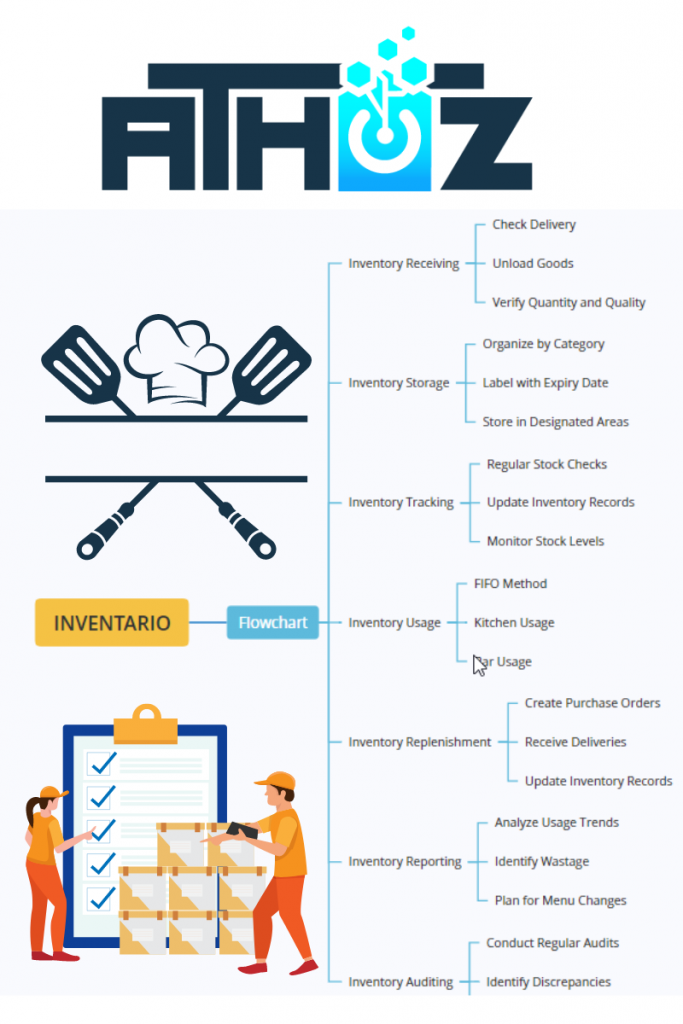
Running a restaurant requires an efficient inventory system. However, it is important to keep in mind that staff training is essential to ensure its correct functioning. Although the implementation of innovative technology is beneficial, its success depends on proper processes and a passionate commitment to efficient management, which relates to work culture.
It is essential to consider the disadvantages that arise with lack of staff training or inadequate staffing when placing product requests for the restaurant, such as:
- Loss of inventory due to inaccurate orders.
- Obsolete inventory and food waste due to lack of proper monitoring and control.
- Unnecessary expenses due to the purchase of non-essential products.
Therefore, it is essential to have an efficient inventory system and properly trained personnel for its correct implementation and operation.
A general summary of how inventories work in this context:
Product Registration: It starts with the creation of a detailed catalog of all the products present in the inventory. This includes food, beverages, utensils, and other supplies.
Code and Categorization System: It is important that this process can be created from the circulation or rotation of your product, which will automatically be the requirement for receiving the product and control of what is received.
Inputs and Outputs: The entries of new products to the inventory are recorded, either through purchases or internal transfers. Similarly, the output of products due to sales, internal consumption, or losses is recorded.
Real-Time Stock Management: Many companies use automated systems that allow real-time inventory control. This implies the use of specialized software that automatically updates the available quantities.
Inventory Rotation: Inventory rotation is implemented to ensure that the oldest products are used first. This is crucial in the food industry to avoid obsolescence and ensure freshness.
Periodic Physical Inventories: Although automated systems are used, it is common to carry out periodic physical inventories to verify the accuracy of the system and correct possible discrepancies.
Records to Comply with Regulations: It is important to maintain accurate records to comply with local and federal regulations. This includes tracking expiration dates, batches, and other relevant details.
Data Analysis: Inventory data is regularly analyzed to make informed decisions on replenishment, price adjustments and process optimization.
It is essential to follow good inventory management practices to ensure an efficient and profitable operation. In the restaurant industry, where perishable products are common, accurate inventory management is even more critical to avoid waste and ensure food quality.
| Point | Description | Benefit | Money Savings |
| Product Registration | Creation of a detailed product catalog. | Better organization and tracking of all items. | Reduction of losses due to lack of control and order. |
| Code and Categorization System | Labeling and categorization for efficient identification. | Agility in searching and efficient inventory management. | Savings in time and resources. |
| Entrances and Exits | Registration of product movements (entries and exits). | Transparency in the management and prevention of shortages. | Avoid unnecessary purchases and losses due to lack of stock. |
| Stock Management in Real Time | Use of automated systems for real-time control. | Greater efficiency by avoiding errors and losses due to outdated. | Reduction of losses and optimization of resources. |
| Inventory rotation | Implementing a system to use older products first. | Prevents obsolescence and guarantees the freshness of products. | Reduction of losses due to expiration and obsolete products. |
| Point | Description | Benefit | Money Savings |
| Periodic Physical Inventories | Performing physical counts to verify system accuracy. | Corrects potential discrepancies and maintains inventory accuracy. | Avoid erroneous decisions based on incorrect data. |
| Records to Comply with Regulations | Maintaining accurate records to comply with local and federal regulations. | Legal compliance and prevention of sanctions. | Avoid fines and penalties. |
To improve inventory management, you can implement a product rotation system to avoid obsolescence, properly train staff, automate inventory systems to minimize human errors, perform periodic analysis of inventory data to identify patterns and trends, and integrate the inventory system with suppliers for more efficient management of orders and deliveries.

Remember that the successful implementation of an inventory system requires commitment and collaboration from all personnel involved.
The advantages of using an inventory system in a restaurant will always be beneficial and a better decision than doing it manually, leaving everything in the responsibility of the collaborator.
Although it may seem difficult to implement, it is simpler and especially if you are working in a company that you want to lead to success, you should not waste time and implement it. Some advantages below:
| Benefit Description | Described Benefit | Savings in Percentage |
| Stock Control in Real Time | It allows you to monitor product stocks in real time. | Greater efficiency and loss prevention. |
| Reduction of Human Errors | Eliminates errors associated with manual counts. | Less product loss and better precision. |
| Order Optimization | Makes it easy to identify products that need replenishment. | Savings by avoiding excesses or shortages in orders. |
| Inventory Turnover Analysis | It allows you to evaluate the speed of sales and product rotation. | Better planning and reduction of obsolete products. |
| Storage Costs | Helps avoid excess storage and optimize space. | Reduction of costs associated with storage. |
With Love
ATHOZ / www.athoz.net / @athoz.io (Instagram, Facebook,TikTok).
The second part will come soon.



